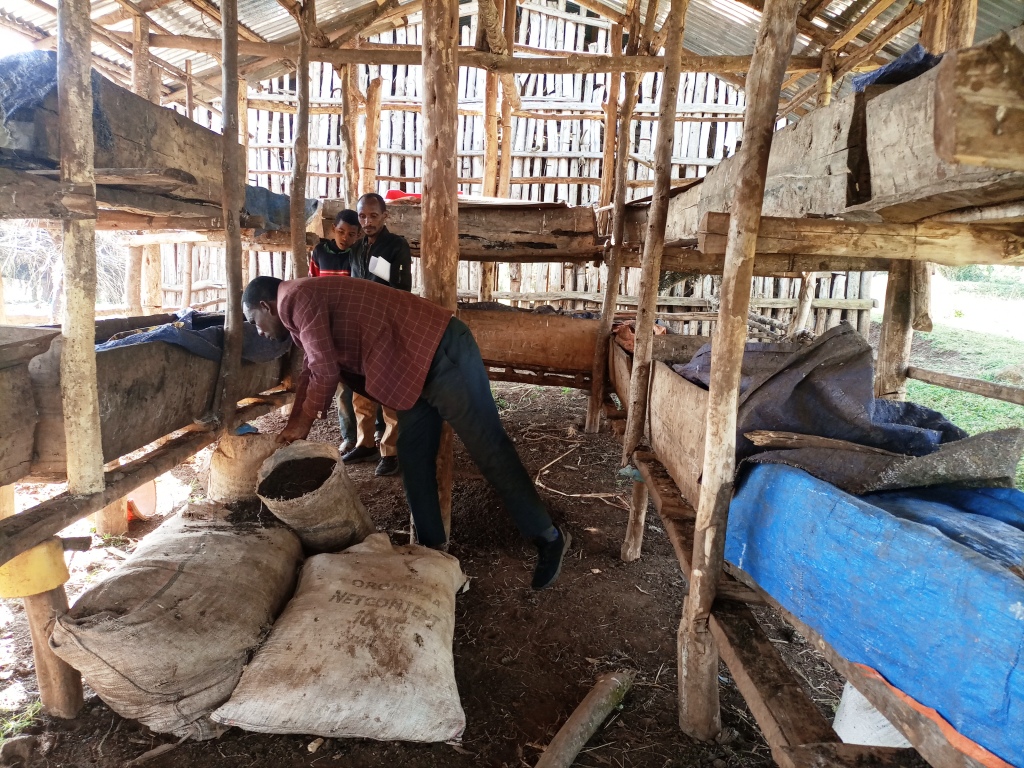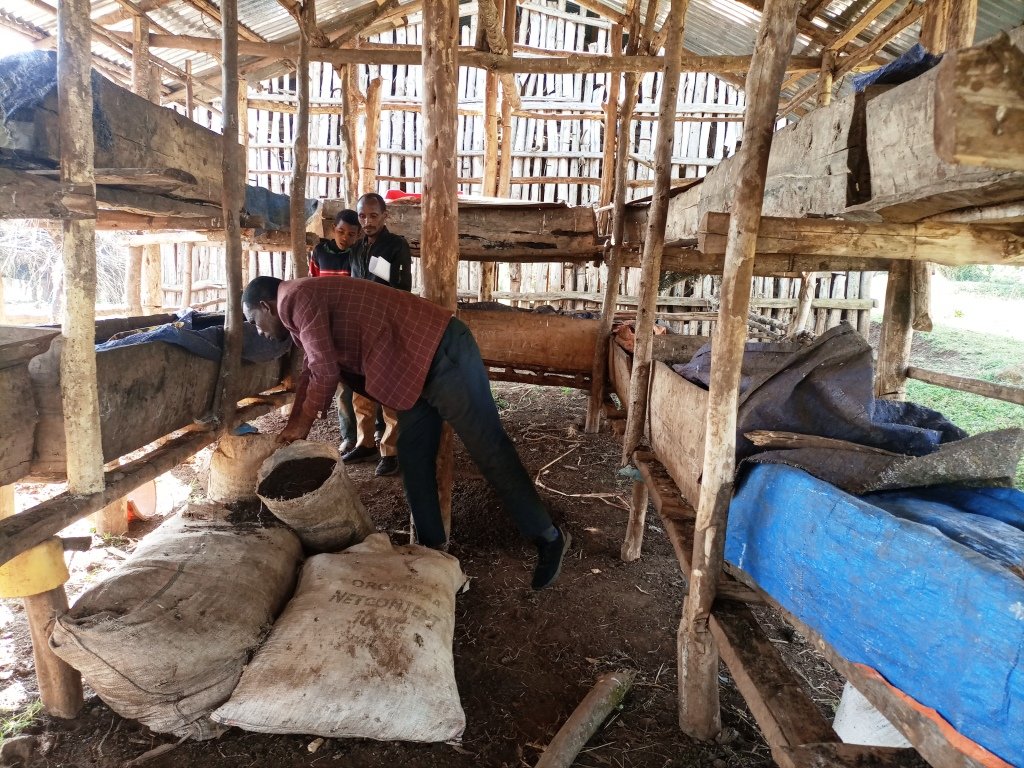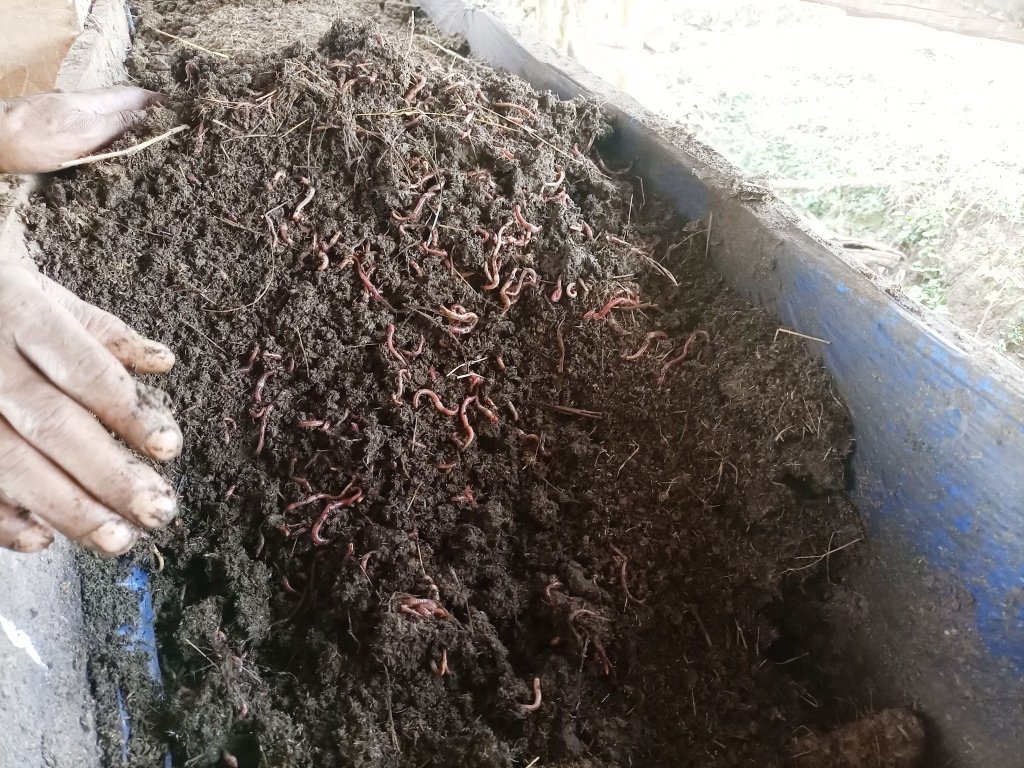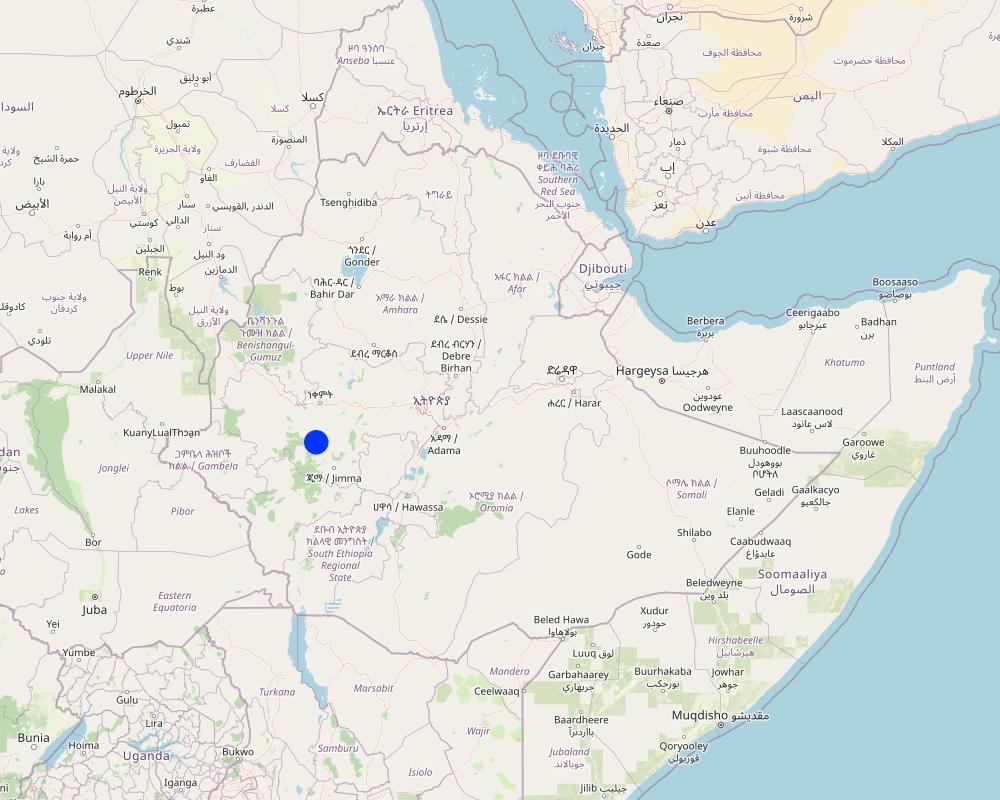Vermicomposting [Ethiopia]
- Creation:
- Update:
- Compiler: GERBA LETA
- Editors: Noel Templer, Julia Doldt, Kidist Yilma, Likissa Kurmana Dufera, Tabitha Nekesa, Ahmadou Gaye, Siagbé Golli
- Reviewers: William Critchley, Rima Mekdaschi Studer, Sally Bunning
Komposti Ramo
technologies_6643 - Ethiopia
View sections
Expand all Collapse all1. General information
1.2 Contact details of resource persons and institutions involved in the assessment and documentation of the Technology
Key resource person(s)
land user:
Dinqa Degu
Farmer
Ethiopia
1.3 Conditions regarding the use of data documented through WOCAT
The compiler and key resource person(s) accept the conditions regarding the use of data documented through WOCAT:
Yes
1.4 Declaration on sustainability of the described Technology
Is the Technology described here problematic with regard to land degradation, so that it cannot be declared a sustainable land management technology?
No
Comments:
The technology restores degraded soil and reduces investment costs on chemical fertilizers.
1.5 Reference to Questionnaire(s) on SLM Approaches (documented using WOCAT)
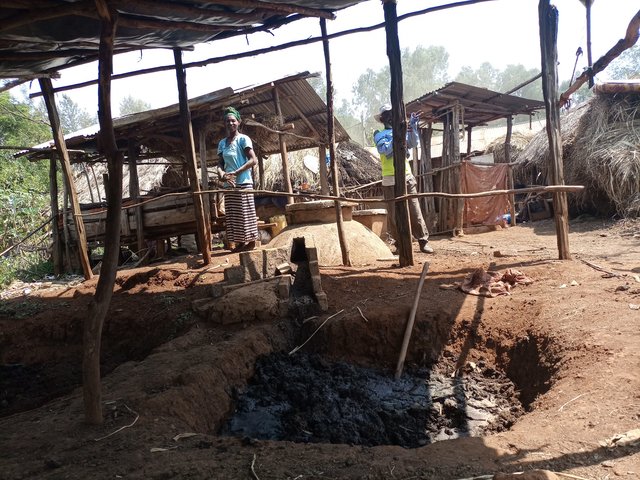
Integrated Soil Fertility Management (ISFM) [Ethiopia]
The Integrated Soil Fertility Management (ISFM) approach has been adopted under the Integrated Soil Fertility Management Project (ISFM+). It was introduced as a quick-win solution to increase both crop and biomass production through the incremental promotion of varied but complementary technology packages.
- Compiler: GERBA LETA
2. Description of the SLM Technology
2.1 Short description of the Technology
Definition of the Technology:
Vermicompost is the product of the decomposition process using various species of earthworms. It is a form of humus and is produced through worms digesting and excreting organic in their casts. Vermicompost has been shown to be an effective organic soil amendment, reducing the need for inorganic fertilizers.
2.2 Detailed description of the Technology
Description:
Vermicomposting is the process by which worms convert organic materials (usually wastes) into a humus-like material known as vermicompost. The process is an aerobic, bio-oxidation, non-thermophilic process of organic decomposition that depends upon earthworms to fragment, mix and promote microbial activity. In making vermicompost, earthworms are very good at transforming dead plant material, and livestock droppings into excellent manure. The excrement of the worms has high nutrient levels and a growth‐promoting effect on plants. Earthworms are very sensitive to changes in moisture and temperature. They need a continuous food supply and protection from ants, birds, and chickens. Compared to ordinary compost making, it needs maximum care. For optimum management practices, vermicompost production must be located close to the homestead where livestock barns are usually located. Livestock droppings (especially those of horses and donkeys) are the best sources of feed in addition to plant biomass and other household refuses. Vermicompost production needs a bin in which the worms live. This holds the bedding and food scraps, regulates the amount of moisture and temperature in the bedding, and blocks light which is harmful to the nocturnal worms. Worm bins can be made from plastic or wooden materials. In Ethiopia, wooden boxes are preferred because they are more absorbent and provide better insulation.
Vermicompost reduces farmers’ investment costs on chemical fertilizers. It also has a sustainable role in restoring soil fertility, ameliorating soil acidity and rehabilitating degraded farmland – all of which are problems in the southwestern part of Ethiopia. In the farm where vermicompost is applied, newly transplanted seedlings, in the case of vegetables, remain green and resilient as the compost improves not only the nutrients but also the moisture content of the soil. According to the land users, annual and perennial crops such as horse beans (Vicia faba), wheat, cabbages and avocados grown under vermicompost do very well. Under ideal conditions, 1,000 earthworms can convert 45kg of wet biomass per week into about 25kg of vermicompost. Therefore, the size of production depends on the number of worms, supply of foods, availability of boxes, and associated management practices. In rows and spot application of vermicompost during planting the crop allows efficient and effective uses of the products.
Currently (2023) the government in the southwestern zones of Oromia Region is promoting vermicompost as a vital organic fertilizer. This signals a change in the public sector's and end-users’ mindset in the use of organic fertilizer as a reliable soil amendment, particularly in acid-prone areas. In general, compost restores soil fertility, increases crop production and improves the livelihood of the end users. While the initial cost of constructing the house and installing bins and worms is high, there is potential for the use of local materials. However, it demands considerable household labour for upkeep.
2.3 Photos of the Technology
2.4 Videos of the Technology
Comments, short description:
Video of the technology was not taken.
2.5 Country/ region/ locations where the Technology has been applied and which are covered by this assessment
Country:
Ethiopia
Region/ State/ Province:
Oromia, Buno-Bedele Zone
Further specification of location:
Gechi district
Specify the spread of the Technology:
- applied at specific points/ concentrated on a small area
Is/are the technology site(s) located in a permanently protected area?
No
Comments:
The technology is located close to the home.
Map
×2.6 Date of implementation
Indicate year of implementation:
2020
If precise year is not known, indicate approximate date:
- less than 10 years ago (recently)
2.7 Introduction of the Technology
Specify how the Technology was introduced:
- through land users' innovation
- through projects/ external interventions
Comments (type of project, etc.):
ISFM+ project (Integrated Soil Fertility Management Project of the GIZ).
3. Classification of the SLM Technology
3.1 Main purpose(s) of the Technology
- improve production
- reduce, prevent, restore land degradation
- protect a watershed/ downstream areas – in combination with other Technologies
- preserve/ improve biodiversity
- create beneficial economic impact
3.2 Current land use type(s) where the Technology is applied
Land use mixed within the same land unit:
No

Cropland
- Annual cropping
Annual cropping - Specify crops:
- cereals - wheat (spring)
- vegetables - root vegetables (carrots, onions, beet, other)
- legumes and pulses - beans
Number of growing seasons per year:
- 1
Is intercropping practiced?
No
Is crop rotation practiced?
Yes
If yes, specify:
Cereals with legumes (wheat with faba beans/horse beans).
3.3 Has land use changed due to the implementation of the Technology?
Has land use changed due to the implementation of the Technology?
- No (Continue with question 3.4)
3.4 Water supply
Water supply for the land on which the Technology is applied:
- mixed rainfed-irrigated
Comments:
Vermicompost was applied to produce Faba beans under rainfed and vegetable production under irrigated conditions.
3.5 SLM group to which the Technology belongs
- integrated crop-livestock management
- integrated soil fertility management
- integrated pest and disease management (incl. organic agriculture)
3.6 SLM measures comprising the Technology

agronomic measures
- A2: Organic matter/ soil fertility
- A3: Soil surface treatment
- A4: Subsurface treatment

management measures
- M2: Change of management/ intensity level
3.7 Main types of land degradation addressed by the Technology

soil erosion by water
- Wt: loss of topsoil/ surface erosion
- Wg: gully erosion/ gullying

chemical soil deterioration
- Cn: fertility decline and reduced organic matter content (not caused by erosion)
- Ca: acidification

physical soil deterioration
- Pc: compaction
- Ps: subsidence of organic soils, settling of soil
- Pu: loss of bio-productive function due to other activities

biological degradation
- Bc: reduction of vegetation cover
- Bh: loss of habitats
- Bq: quantity/ biomass decline
- Bs: quality and species composition/ diversity decline
- Bl: loss of soil life
3.8 Prevention, reduction, or restoration of land degradation
Specify the goal of the Technology with regard to land degradation:
- reduce land degradation
- restore/ rehabilitate severely degraded land
Comments:
Chemical fertilizers trigger the soil to dry compared to vermicompost, which keeps the soil moist and the structure firm and coherent. This indicates relieving the degraded soil by changing its color and properties. Also, it allows an increase in the biodiversity of flora and fauna.
4. Technical specifications, implementation activities, inputs, and costs
4.1 Technical drawing of the Technology
Technical specifications (related to technical drawing):
The box is also made with wooden pegs supported with thin horizontal bars and plastered by mud made of soil and water mixed with straw of teff (Eragrostis tef). The box is usually 3 meters long, 60 cm wide, and 50 cm deep, with a total capacity of carrying 0.9 m3 of worms and feedstock at a time. This is a manageable size with 50 cm wide between the structure to allow mobility of the caregivers for effective management of vermicompost.
Author:
Gerba Leta
Date:
04/02/2023
4.2 General information regarding the calculation of inputs and costs
Specify how costs and inputs were calculated:
- per Technology unit
Specify unit:
House, boxes, worms, labor...
Specify dimensions of unit (if relevant):
The preferred box size is 3m (L) x 50cm (W) x 30cm (H) with holes (0.5cm diameter).
other/ national currency (specify):
ETB
If relevant, indicate exchange rate from USD to local currency (e.g. 1 USD = 79.9 Brazilian Real): 1 USD =:
53.12
Indicate average wage cost of hired labour per day:
200
4.3 Establishment activities
| Activity | Timing (season) | |
|---|---|---|
| 1. | Constructing house or huts. | Anytime, preferable before the main cropping season. |
| 2. | Build or purchase the worm bin/ boxes/structure with same function. | Anytime, preferable before the main cropping season. |
| 3. | Purchase and/or introduce the worms. | Anytime, preferable before the main cropping season. |
| 4. | Add the food and water to the box/structure. | Regularly, through monitoring the status of the worms in the bin/box. |
| 5. | Monitor the surround from the predators and aerate the structure. | Regular monitoring is commendable. |
| 6. | Harvest and dry the vermicompost for use. | When the worms feed on the feedstock and cast the compost (brown humus). |
4.4 Costs and inputs needed for establishment
| Specify input | Unit | Quantity | Costs per Unit | Total costs per input | % of costs borne by land users | |
|---|---|---|---|---|---|---|
| Labour | Labor | PDs | 183.0 | 200.0 | 36600.0 | 100.0 |
| Equipment | Boxes | number | 14.0 | 250.0 | 3500.0 | 100.0 |
| Other | House with corrugated iron sheet | Lump sum | 1.0 | 25000.0 | 25000.0 | 100.0 |
| Other | Worms | kg | 12.0 | 500.0 | 6000.0 | |
| Total costs for establishment of the Technology | 71100.0 | |||||
| Total costs for establishment of the Technology in USD | 1338.48 | |||||
If land user bore less than 100% of costs, indicate who covered the remaining costs:
ISFM+ project of the GIZ covered some minor costs of a farmer.
Comments:
Labour cost is estimated for a year, each with half a day for follow-up and care. The establishment price is just an estimation. A farmer can start with a few boxes: a couple or more boxes made of local materials that are less costly. Therefore, the estimation is based on the model farmer's approach since he used corrugated iron sheet roofed house and wooden boxes to establish the vermiculture/ vermicompost production center. Otherwise, locally available materials can be used to build hats and wooden structure with plastic lining to serve as boxes. Once established, the recurrent cost is limited to labor and some pesticides.
4.5 Maintenance/ recurrent activities
| Activity | Timing/ frequency | |
|---|---|---|
| 1. | Labour to supply feedstock and provision of other related management practices. | It needs follow-up and supplying the feedstock throughout the year. |
Comments:
It demands supplying feedstock and water, protecting the worms from predators, and providing other management practices.
4.6 Costs and inputs needed for maintenance/ recurrent activities (per year)
| Specify input | Unit | Quantity | Costs per Unit | Total costs per input | % of costs borne by land users | |
|---|---|---|---|---|---|---|
| Labour | Labor for follow-up and related practices | PDs | 183.0 | 200.0 | 36600.0 | 100.0 |
| Total costs for maintenance of the Technology | 36600.0 | |||||
| Total costs for maintenance of the Technology in USD | 689.01 | |||||
Comments:
Family must sources free labour at least for half a day throughout the year.
4.7 Most important factors affecting the costs
Describe the most determinate factors affecting the costs:
The cost is consistently changing. It might be attributed to the economic crisis and the growing inflation.
5. Natural and human environment
5.1 Climate
Annual rainfall
- < 250 mm
- 251-500 mm
- 501-750 mm
- 751-1,000 mm
- 1,001-1,500 mm
- 1,501-2,000 mm
- 2,001-3,000 mm
- 3,001-4,000 mm
- > 4,000 mm
Indicate the name of the reference meteorological station considered:
Bedele
Agro-climatic zone
- sub-humid
5.2 Topography
Slopes on average:
- flat (0-2%)
- gentle (3-5%)
- moderate (6-10%)
- rolling (11-15%)
- hilly (16-30%)
- steep (31-60%)
- very steep (>60%)
Landforms:
- plateau/plains
- ridges
- mountain slopes
- hill slopes
- footslopes
- valley floors
Altitudinal zone:
- 0-100 m a.s.l.
- 101-500 m a.s.l.
- 501-1,000 m a.s.l.
- 1,001-1,500 m a.s.l.
- 1,501-2,000 m a.s.l.
- 2,001-2,500 m a.s.l.
- 2,501-3,000 m a.s.l.
- 3,001-4,000 m a.s.l.
- > 4,000 m a.s.l.
Indicate if the Technology is specifically applied in:
- not relevant
Comments and further specifications on topography:
The altitude is also descending as one travel from highland to lowland agroecology.
5.3 Soils
Soil depth on average:
- very shallow (0-20 cm)
- shallow (21-50 cm)
- moderately deep (51-80 cm)
- deep (81-120 cm)
- very deep (> 120 cm)
Soil texture (topsoil):
- medium (loamy, silty)
Soil texture (> 20 cm below surface):
- medium (loamy, silty)
Topsoil organic matter:
- medium (1-3%)
5.4 Water availability and quality
Ground water table:
5-50 m
Availability of surface water:
good
Water quality (untreated):
poor drinking water (treatment required)
Water quality refers to:
ground water
Is water salinity a problem?
No
Is flooding of the area occurring?
No
5.5 Biodiversity
Species diversity:
- medium
Habitat diversity:
- medium
Comments and further specifications on biodiversity:
Species diversity has been improved with the application of compost to the farm.
5.6 Characteristics of land users applying the Technology
Sedentary or nomadic:
- Sedentary
Market orientation of production system:
- mixed (subsistence/ commercial)
Off-farm income:
- 10-50% of all income
Relative level of wealth:
- very rich
Individuals or groups:
- individual/ household
Level of mechanization:
- animal traction
Gender:
- men
Age of land users:
- middle-aged
5.7 Average area of land used by land users applying the Technology
- < 0.5 ha
- 0.5-1 ha
- 1-2 ha
- 2-5 ha
- 5-15 ha
- 15-50 ha
- 50-100 ha
- 100-500 ha
- 500-1,000 ha
- 1,000-10,000 ha
- > 10,000 ha
Is this considered small-, medium- or large-scale (referring to local context)?
- small-scale
5.8 Land ownership, land use rights, and water use rights
Land ownership:
- state
- individual, titled
Land use rights:
- open access (unorganized)
- individual
Water use rights:
- open access (unorganized)
Are land use rights based on a traditional legal system?
No
Specify:
Land use right is half inherited, and the other half is self-appropriated but got approval from the local administration.
Comments:
The land user appropriated some parts of his possession and has changed the marshy land to a farm where irrigation water is accessible.
5.9 Access to services and infrastructure
health:
- poor
- moderate
- good
education:
- poor
- moderate
- good
technical assistance:
- poor
- moderate
- good
employment (e.g. off-farm):
- poor
- moderate
- good
markets:
- poor
- moderate
- good
energy:
- poor
- moderate
- good
roads and transport:
- poor
- moderate
- good
drinking water and sanitation:
- poor
- moderate
- good
financial services:
- poor
- moderate
- good
6. Impacts and concluding statements
6.1 On-site impacts the Technology has shown
Socio-economic impacts
Production
crop production
Quantity before SLM:
Abandoned for faba beans
Quantity after SLM:
1.2 tons/ha
Comments/ specify:
The yield of Faba bean increased from negligible yield where a farmer abandoned it to over 1 ton per hectare.
crop quality
Comments/ specify:
It was not scientifically measured but the farmer communicated the harvest of good seed size with better tastes as compared to the harvest without using vermicompost.
fodder production
Comments/ specify:
There is an assumption and evidence that validate that compost favors the growth of diverse wild species. Also, it increases biomass production that associates with fodder or feed production.
product diversity
Comments/ specify:
The use of vermicompost enables to regain of the lost crop species because of soil degradation.
land management
Comments/ specify:
As it added organic matter to the soil, it improves soil structure and other attributes of the soil that improve the land.
Income and costs
expenses on agricultural inputs
Comments/ specify:
It reduces investment on synthetic fertilizers and allows to harvest organic products.
farm income
Comments/ specify:
As most of the distinctions between the treatments with SLM technology vs without technology are not properly documented by the land users, it is difficult to quantify them. However, the evidence from the demonstration plots shows the yield increments by more than quadruple per unit of land. Since then the technology is applied recently, and promoting documentation of the yield difference by the land users themselves is commendable to ensure access to reliable data.
Socio-cultural impacts
food security/ self-sufficiency
Comments/ specify:
Generally, it added value to the efforts of ensuring food as well as nutrition security.
health situation
Comments/ specify:
Health situation is converging with ensured food and nutrition security.
SLM/ land degradation knowledge
Comments/ specify:
Increased through exchange visit and participatory learning of the effect of the technology on the farm.
situation of socially and economically disadvantaged groups
Comments/ specify:
Slightly improved with access and use of the technology.
Ecological impacts
Water cycle/ runoff
surface runoff
Comments/ specify:
This is with the assumption that vermicompost improve soil structure via the addition of organic matter and improves water infiltration than favoring runoff.
excess water drainage
Soil
soil moisture
soil cover
soil loss
soil accumulation
soil crusting/ sealing
soil compaction
nutrient cycling/ recharge
soil organic matter/ below ground C
acidity
Biodiversity: vegetation, animals
Vegetation cover
biomass/ above ground C
plant diversity
animal diversity
beneficial species
habitat diversity
Climate and disaster risk reduction
emission of carbon and greenhouse gases
Specify assessment of on-site impacts (measurements):
Vermicompost improves soil properties and related attributes to crop and the environment. Most of the assumptions made here are based on the knowledge and skills of SLM experts and land users than the empirical analysis because there is no such detailed data documented and available either by the land users or the project itself.
6.2 Off-site impacts the Technology has shown
water availability
reliable and stable stream flows in dry season
downstream flooding
downstream siltation
Specify assessment of off-site impacts (measurements):
As the application of the technology is on a plot basis, assessing its off-site effects necessitates widespread adoption and application of the technology. This may need long terms and intensive follow-up.
6.3 Exposure and sensitivity of the Technology to gradual climate change and climate-related extremes/ disasters (as perceived by land users)
Gradual climate change
Gradual climate change
| Season | increase or decrease | How does the Technology cope with it? | |
|---|---|---|---|
| annual rainfall | decrease | well | |
| seasonal rainfall | summer | decrease | moderately |
6.4 Cost-benefit analysis
How do the benefits compare with the establishment costs (from land users’ perspective)?
Short-term returns:
slightly negative
Long-term returns:
very positive
How do the benefits compare with the maintenance/ recurrent costs (from land users' perspective)?
Short-term returns:
positive
Long-term returns:
very positive
6.5 Adoption of the Technology
- 1-10%
Of all those who have adopted the Technology, how many did so spontaneously, i.e. without receiving any material incentives/ payments?
- 0-10%
Comments:
As the technology is recently introduced, the level of awareness is low and it is in the pilot phase.
6.6 Adaptation
Has the Technology been modified recently to adapt to changing conditions?
Yes
other (specify):
Produced the boxes from local materials such as mud and posts.
Specify adaptation of the Technology (design, material/ species, etc.):
The land users and the district ISFM+ project focal person modified the boxes by building with a bunch of sticks plastered with mud to replace the priceless boxes made up of timbers.
6.7 Strengths/ advantages/ opportunities of the Technology
| Strengths/ advantages/ opportunities in the land user’s view |
|---|
| Reduce investment costs on chemical fertilizers. |
| Partly replace the role of chemical fertilizers. |
| Improve soil fertility and reduces soil acidity. |
| Strengths/ advantages/ opportunities in the compiler’s or other key resource person’s view |
|---|
| Rehabilitate the degraded land and improve the biodiversity of flora and fauna. |
| Reduce risks of crop failure. |
| Creat employment opportunity |
6.8 Weaknesses/ disadvantages/ risks of the Technology and ways of overcoming them
| Weaknesses/ disadvantages/ risks in the land user’s view | How can they be overcome? |
|---|---|
| Labor demanding. | Engage family labor. |
| Shortage of biomass to supply feedstock. | Improve access to biomass supply and improve practical uses of crop residue and animal excreta. |
| Weaknesses/ disadvantages/ risks in the compiler’s or other key resource person’s view | How can they be overcome? |
|---|---|
| Lack of proper documentation by the land users inline with such comprehensive questions. | Promote the capacity of land users to document the various facets of the technology on land management, production, and other multiple pros and cons. |
7. References and links
7.1 Methods/ sources of information
- field visits, field surveys
Two
- interviews with land users
One
- interviews with SLM specialists/ experts
One
When were the data compiled (in the field)?
05/02/2023
7.2 References to available publications
Title, author, year, ISBN:
Organic Exchange. 2009. Soil Fertility Management: An introductory Fact-Sheet for Farmers and Projects.
Available from where? Costs?
Free online
Title, author, year, ISBN:
MoA. 2016. Technical Manual: Integrated Soil Fertility Management. SLMP Training Series 14. Addis Ababa, Ethiopia.
Available from where? Costs?
Free online
7.3 Links to relevant online information
Title/ description:
Vermicomposting
URL:
https://composting.ces.ncsu.edu/vermicomposting-2/
7.4 General comments
Similar to the other integrated soil fertility management practices /technologies, in this questionnaire, there are clearly irrelevant questions to this particular technology or too comprehensive to be addressed by the land users.
Links and modules
Expand all Collapse allLinks

Integrated Soil Fertility Management (ISFM) [Ethiopia]
The Integrated Soil Fertility Management (ISFM) approach has been adopted under the Integrated Soil Fertility Management Project (ISFM+). It was introduced as a quick-win solution to increase both crop and biomass production through the incremental promotion of varied but complementary technology packages.
- Compiler: GERBA LETA
Modules
No modules


